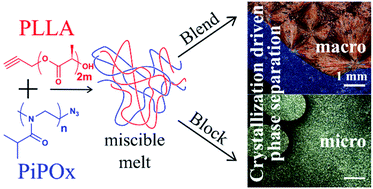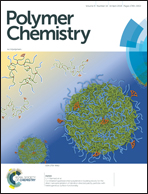Inversion of crystallization rates in miscible block copolymers of poly(lactide)-block-poly(2-isopropyl-2-oxazoline)†
Abstract
Miscible block copolymers (BCPs) are rarely studied. When one or both components of such BCPs are semi-crystalline polymers, strong effects on the crystallization behavior can be expected. We present a study of 18 miscible BCPs comprised of poly(lactide) (PLLA, semi-crystalline and PDLLA, amorphous) and poly(2-isopropyl-2-oxazoline) (PiPOx, semi-crystalline) with PiPOx volume fractions of 0.14 < ϕPiPOx < 0.82. All BCPs exhibit a single glass transition and form a homogeneous melt. Mixing has a plasticizing effect on PiPOx and increases its crystallization rates (DSC). In contrast, the crystallization rates of PLLA are dramatically reduced, or in most cases entirely prevented. During isothermal crystallization at 130 °C, the crystallization rates of the BCPs were inverted in comparison with those of the parent homopolymers. Crystallization drives the BCPs to phase separate and the formed crystalline structure is that of the parent homopolymers. The fast crystallization of PiPOx confines the observed superstructure. The BCPs were studied on multiple length scales – from the atomic level (WAXS, IR spectroscopy) to the meso level (AFM, SAXS) and the macroscopic superstructure (polarized optical microscopy). A mechanism of the structure evolution is presented.



 Please wait while we load your content...
Please wait while we load your content...